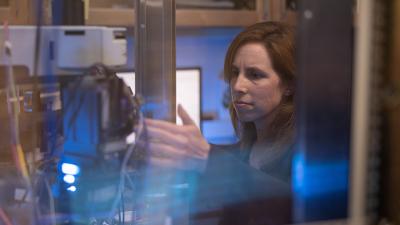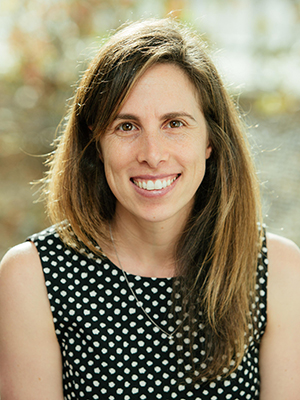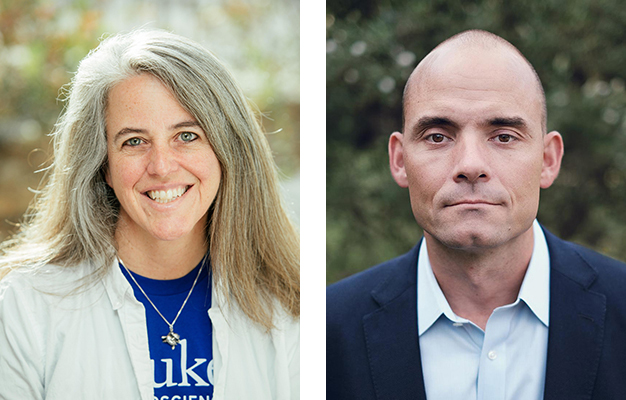

A Fountain of Youth for the Brain
Lindsey Glickfeld is pushing the limits of brain plasticity
Wisdom may come with age, but young people have the advantage when it comes to learning. Duke neurobiologist Lindsey Glickfeld, PhD, wants to know why.
More to the point, she wants to know how. What are the mechanics in the brain and how do those mechanics change from childhood to adulthood?
What she discovers could one day help older people regain some ease of learning. Perhaps it could even lead to a treatment that could help stroke survivors relearn important early skills, like walking and talking.
From an evolutionary perspective, young brains need to be flexible so that kids can pick up language, social skills, and physical abilities in a short period of time.

Brains become more stable moving into adulthood, as it becomes more important to retain hard-won skills rather than soak up new ones. Of course, adults are still capable of learning, but it can require more of an effort.
Think of grandparents struggling with a new phone or television. “If we can figure out how we might be able to give them back a little bit of that learning ability [that children have],” Glickfeld says, “that could really impact their lives in a worthwhile way.”
Glickfeld, associate professor of neurobiology, studies the brain at a cellular level, looking for changes in the circuitry that support learning over stability, or vice versa. She does her research in the visual cortex because it’s one of the most well-understood areas of the brain, so it’s a good jumping off point for pushing frontiers.
She looks at how neurons and synapses – the connections between neurons – work and how different mechanisms in the brain make those connections stronger or weaker. Neural pathways that are used over and over again to, say, identify a familiar object, become well-worn paths along which information travels easily and quickly. But plasticity, aka the ability to learn, depends on neurons and synapses being able to get out of those ruts to make new connections.
“If we can understand the molecular and circuit mechanics that set this balance of stability and flexibility, then potentially we could intervene in order to re-establish that flexibility that adults at all ages need to continue to learn new things,” Glickfeld says.
There are two metaphorical knobs that govern neural pathways in the brain: One makes synapses stronger and another makes them weaker, which frees up energy and resources to allow new pathways to form.
Glickfeld and her collaborators are learning more about the knob that makes connections weaker. They are studying a specific protein called ARC that appears to play a role in turning down the volume on unneeded connections, essentially pruning them. “We think this protein might be really important in this balance of stability versus flexibility in the visual system,” Glickfeld says. “And we’re trying to see how it contributes to potential ongoing plasticity that might be happening in the adult.”
One of Glickfeld’s collaborators at Duke, Anne West, MD, PhD, professor of neurobiology, says, “Later in life, your brain is thought to be more fixed, but what Lindsey has actually found with some of the measurements in the visual cortex is that it’s changing a lot day to day – more than we expected.”
The research has exciting implications not just for adults hoping to learn how to use their new televisions, but for those who have lost neurons due to stroke. “If we could figure out how to tap into this mechanism,” West says, “we could open up plasticity in the rest of the brain and those [lost] functions could move to a new part of the brain.”
Glickfeld and West work with Charles Gersbach, PhD, the John W. Strohbehn Distinguished Professor of Biomedical Engineering.

“We each have an expertise the other doesn’t have,” West says. “This was a perfect storm of collaboration.”
In addition to potentially making learning easier for adults – stroke survivors or not – the work of the trio could inform artificial intelligence research by providing a better model for how brain circuits are set up.
But in any case, the first step is understanding the actual mechanics in a healthy brain.
“We need to understand what is regulating the balance of stability and flexibility before we can address or fix dysregulation in different disease states,” Glickfeld says. “We can’t know how to fix the brain when it’s not working until we have a basic understanding of how the brain is working.”
Mary-Russell Roberson is a freelance writer based in Durham.
Story originally published with Duke Science and Technology.